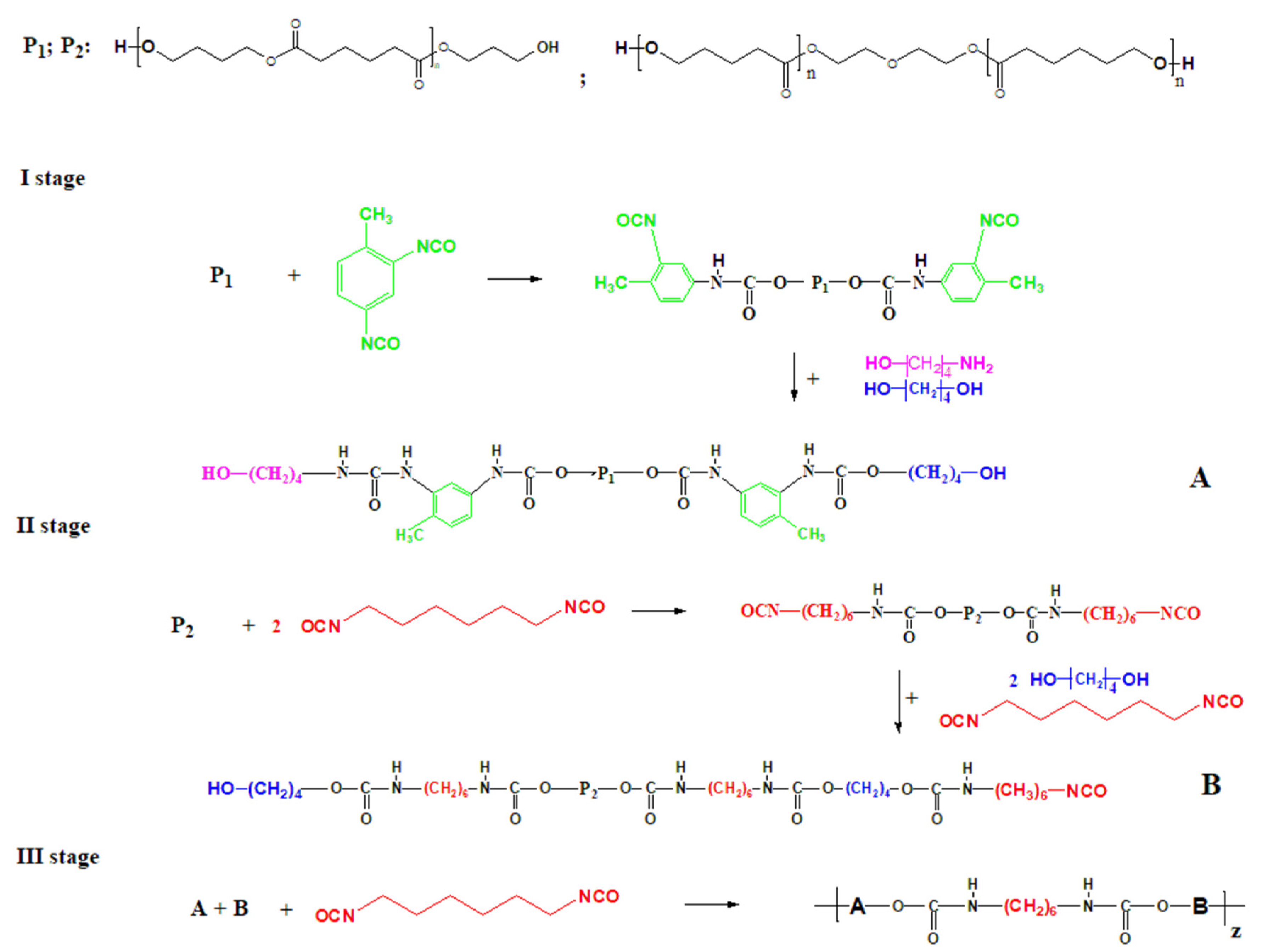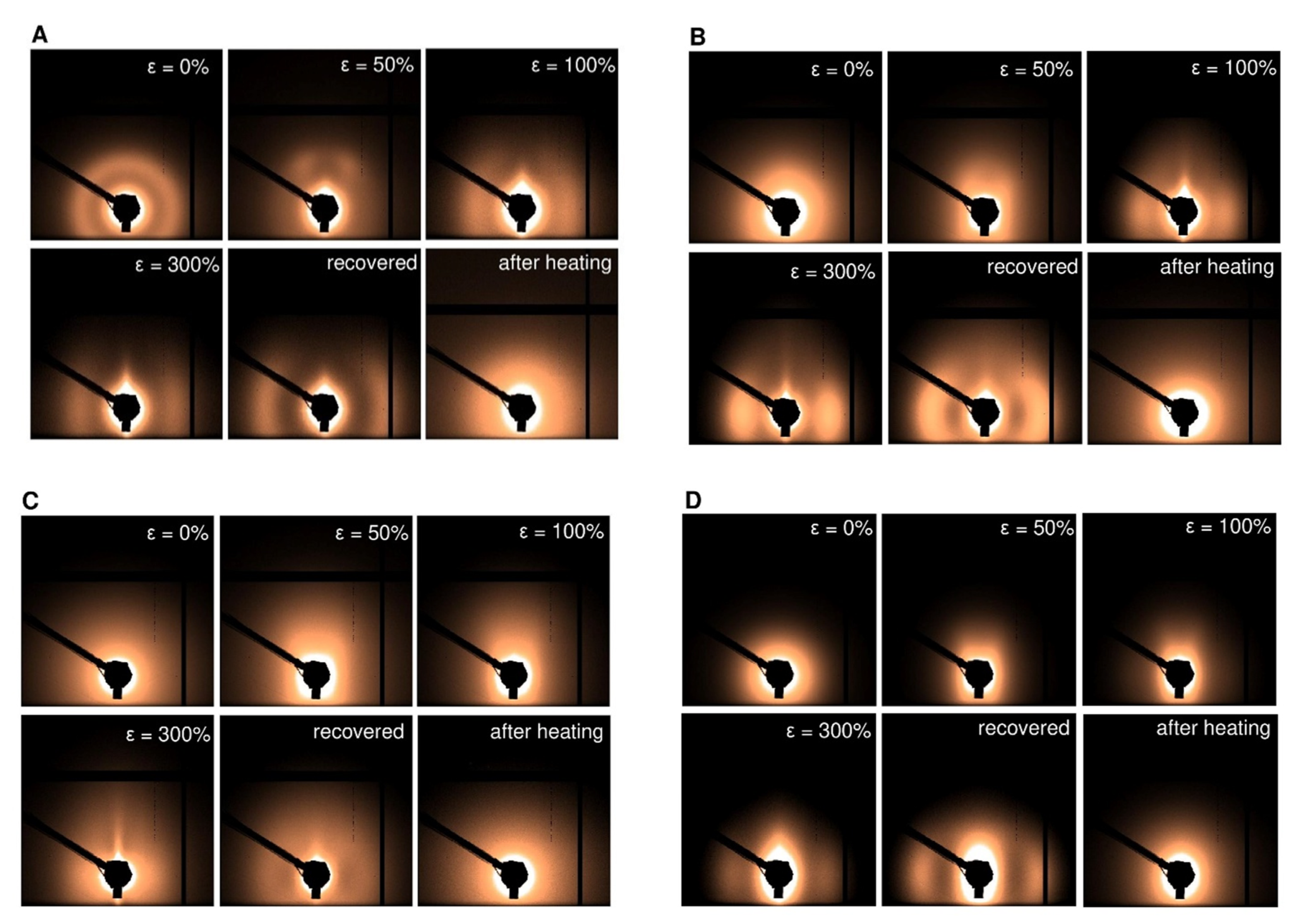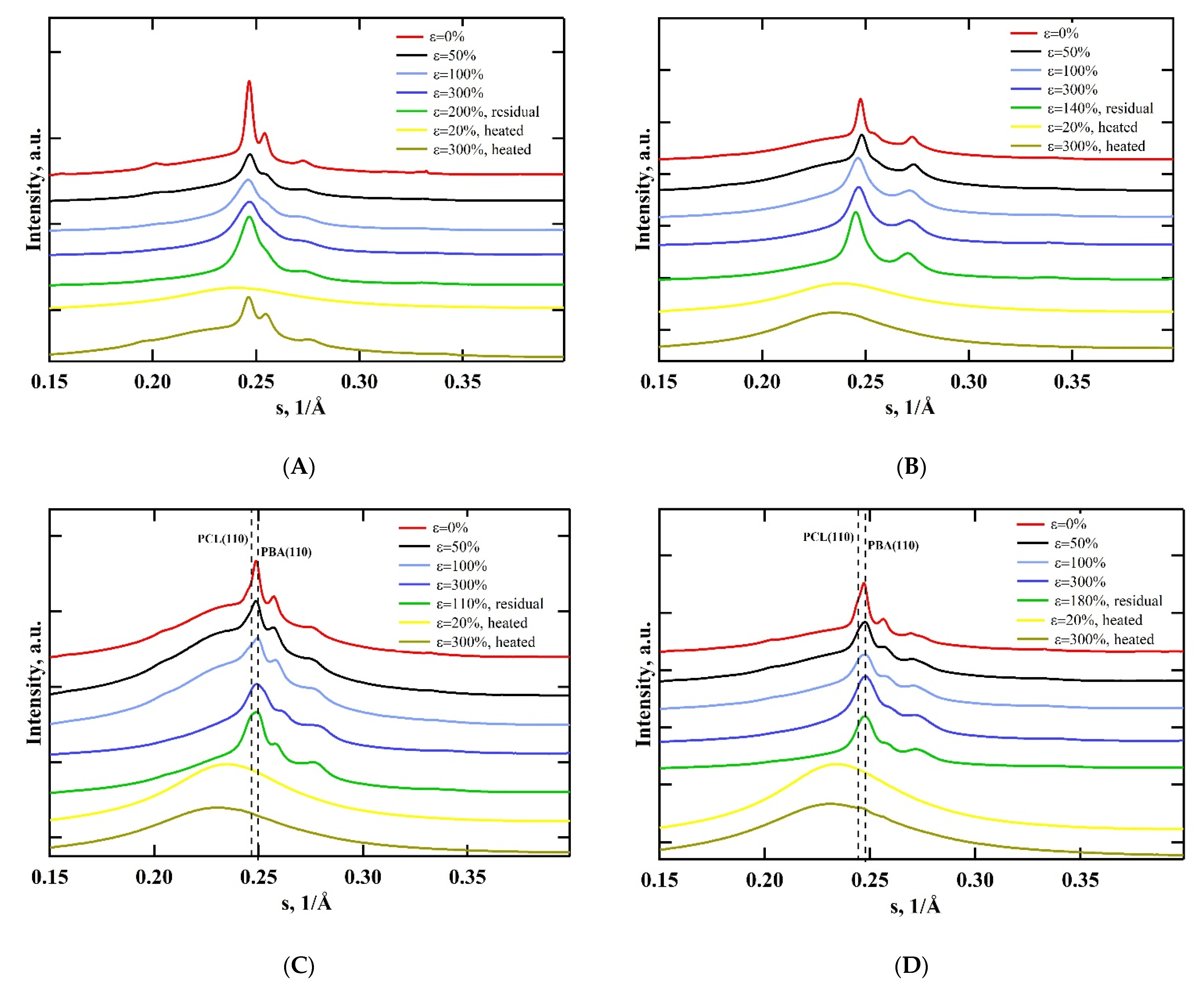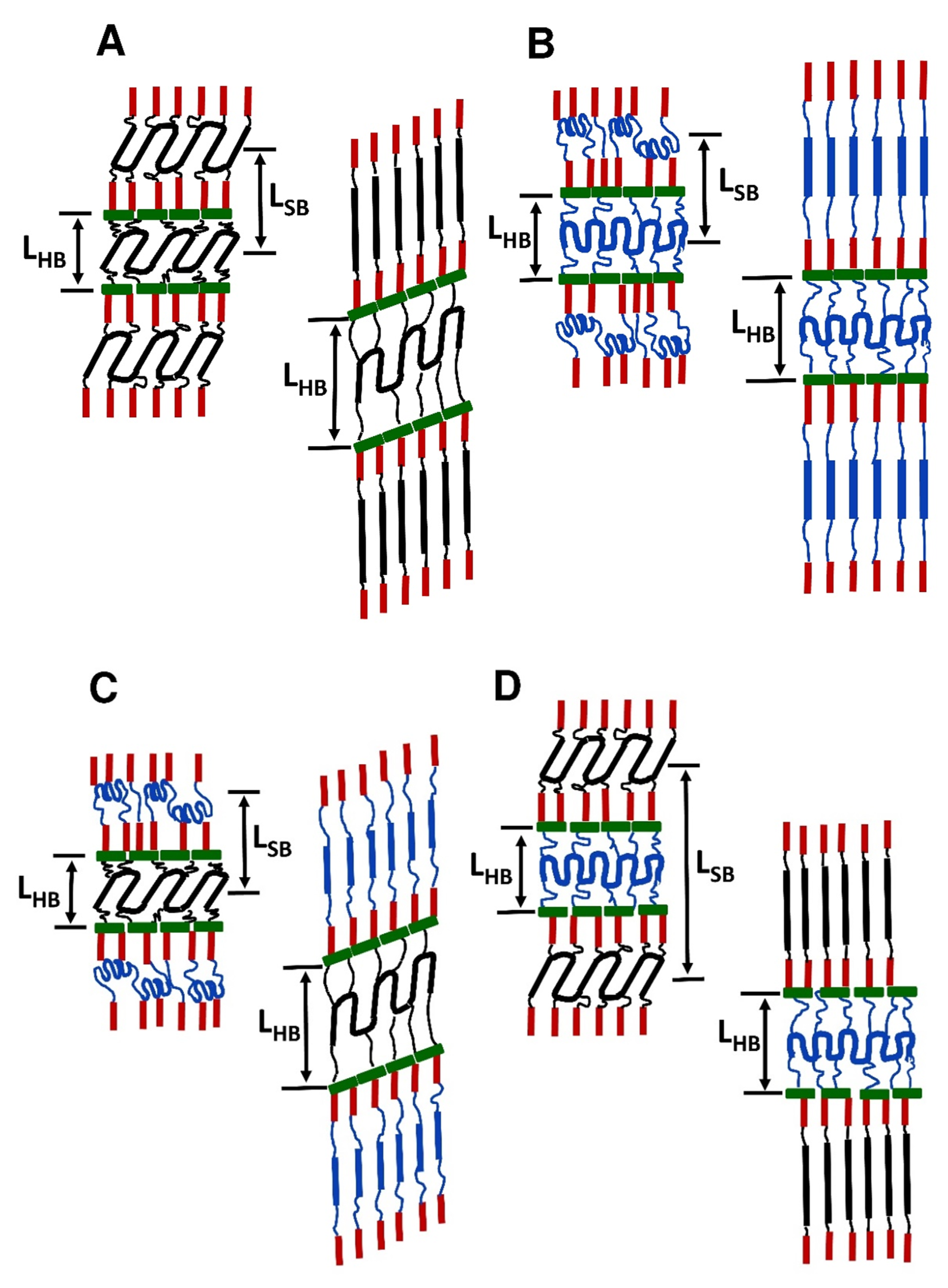Multiblock Thermoplastic Polyurethanes: In Situ Studies of Structural and Morphological Evolution under Strain
Abstract
1. Introduction
2. Materials and Methods
2.1. Materials
2.2. Synthesis of Multiblock Thermoplastic Polyurethane Urea
2.3. Experimental Techniques
3. Results and Discussions
4. Conclusions
Author Contributions
Funding
Institutional Review Board Statement
Informed Consent Statement
Data Availability Statement
Conflicts of Interest
References
- Wang, W.; Wang, C. Polyurethane for Biomedical Applications: A Review of Recent Developments; Elsevier Masson SAS: Cambridge, UK, 2012. [Google Scholar] [CrossRef]
- Liu, Y.F.; Wu, J.L.; Zhang, J.X.; Peng, W. Feasible Evaluation of the Thermo-Mechanical Properties of Shape Memory Polyurethane for Orthodontic Archwire. J. Med. Biol. Eng. 2017, 37, 666–674. [Google Scholar] [CrossRef]
- Huang, W. Thermo-Moisture Responsive Polyurethane Shape Memory Polymer for Biomedical Devices. Open Med. Devices J. 2010, 2, 11–19. [Google Scholar] [CrossRef]
- Haryńska, A.; Kucinska-Lipka, J.; Sulowska, A.; Gubanska, I.; Kostrzewa, M.; Janik, H. Medical-Grade PCL Based Polyurethane System for FDM 3D Printing—Characterization and Fabrication. Materials 2019, 12, 887. [Google Scholar] [CrossRef]
- Kuang, W.; Mather, P.T. A Latent Crosslinkable PCL-Based Polyurethane: Synthesis, Shape Memory, and Enzymatic Degradation. J. Mater. Res. 2018, 33, 2463–2476. [Google Scholar] [CrossRef]
- Gorbunova, M.A.; Shukhardin, D.M.; Lesnichaya, V.A.; Badamshina, E.R.; Anokhin, D.V. New Polyurethane Urea Thermoplastic Elastomers with Controlled Mechanical and Thermal Properties for Medical Applications. Key Eng. Mater. 2019, 816, 187–191. [Google Scholar] [CrossRef]
- Gorbunova, M.; Komratova, V.; Grishchuk, A.; Badamshina, E.; Anokhin, D. The Effect of Addition of Low-Layer Graphene Nanoparticles on Structure and Mechanical Properties of Polyurethane-Based Block Copolymers. Polym. Bull. 2019, 76, 5813–5829. [Google Scholar] [CrossRef]
- Shi, L.; Zhang, R.-Y.; Ying, W.-B.; Hu, H.; Wang, Y.-B.; Guo, Y.-Q.; Wang, W.-Q.; Tang, Z.-B.; Zhu, J. Polyether-Polyester and HMDI Based Polyurethanes: Effect of PLLA Content on Structure and Property. Chin. J. Polym. Sci. 2019, 37, 1152–1161. [Google Scholar] [CrossRef]
- Callegari, D.; Colombi, S.; Nitti, A.; Simari, C.; Nicotera, I.; Ferrara, C.; Mustarelli, P.; Pasini, D.; Quartarone, E. Autonomous Self-Healing Strategy for Stable Sodium-Ion Battery: A Case Study of Black Phosphorus Anodes. ACS Appl. Mater. Interfaces 2021, 13, 13170–13182. [Google Scholar] [CrossRef] [PubMed]
- Li, X.; Stribeck, A.; Schulz, I.; Pöselt, E.; Eling, B.; Hoell, A. Nanostructure of Thermally Aged Thermoplastic Polyurethane and Its Evolution under Strain. Eur. Polym. J. 2016, 81, 569–581. [Google Scholar] [CrossRef]
- He, Y.; Xie, D.; Zhang, X. The Structure, Microphase-Separated Morphology, and Property of Polyurethanes and Polyureas. J. Mater. Sci. 2014, 49, 7339–7352. [Google Scholar] [CrossRef]
- Yilg, E.; Yilg, I.; Yilgör, I.; Yilgör, E.; Wilkes, G.L. Critical Parameters in Designing Segmented Polyurethanes and Their Effect on Morphology and Properties: A Comprehensive Review. Polymer 2015, 58, A1–A36. [Google Scholar] [CrossRef]
- Gorbunova, M.A.; Anokhin, D.V.; Badamshina, E.R. Recent Advances in the Synthesis and Application of Thermoplastic Semicrystalline Shape Memory Polyurethanes. Polym. Sci. Ser. B 2020, 62, 427–450. [Google Scholar] [CrossRef]
- Yan, W.; Fang, L.; Noechel, U.; Kratz, K.; Lendlein, A. Influence of Deformation Temperature on Structural Variation and Shape-Memory Effect of a Thermoplastic Semi-Crystalline Multiblock Copolymer. Express Polym. Lett. 2015, 9, 624–635. [Google Scholar] [CrossRef]
- Anokhin, D.V.; Gorbunova, M.A.; Estrin, Y.I.; Komratova, V.V.; Badamshina, E.R. The Role of Fast and Slow Processes in the Formation of Structure and Properties of Thermoplastic Polyurethanes. Phys. Chem. Chem. Phys. 2016, 18, 31769–31776. [Google Scholar] [CrossRef] [PubMed]
- Li, M.; Zhang, R.; Li, X.; Wu, Q.; Chen, T.; Sun, P. High-Performance Recyclable Cross-Linked Polyurethane with Orthogonal Dynamic Bonds: The Molecular Design, Microstructures, and Macroscopic Properties. Polymer 2018, 148, 127–137. [Google Scholar] [CrossRef]
- Zhang, H.; Zhao, H.; Zhuo, K.; Hua, Y.; Chen, J.; He, X.; Weng, W.; Xia, H. “Carbolong” Polymers With Near Infrared Triggered, Spatially Resolved and Rapid Self-Healing Properties. Polym. Chem. 2019, 10, 386–394. [Google Scholar] [CrossRef]
- Liu, S.; Yuan, Y.; Li, J.; Sun, S.; Chen, Y. An Optomechanical Study of Mechanoluminescent Elastomeric Polyurethanes with Different Hard Segments. Polym. Chem. 2020, 11, 1877–1884. [Google Scholar] [CrossRef]
- Hermida-Merino, D.; O’Driscoll, B.; Hart, L.R.; Harris, P.J.; Colquhoun, H.M.; Slark, A.T.; Prisacariu, C.; Hamley, I.W.; Hayes, W. Enhancement of Microphase Ordering and Mechanical Properties of Supramolecular Hydrogen-Bonded Polyurethane Networks. Polym. Chem. 2018, 9, 3406–3414. [Google Scholar] [CrossRef]
- Koberstein, J.T.; Russell, T.P. Simultaneous SAXS-DSC Study of Multiple Endothermic Behavior in Polyether-Based Polyurethane Block Copolymers. Macromolecules 1986, 19, 714–720. [Google Scholar] [CrossRef]
- Stribeck, A.; Dabbous, R.; Eling, B.; Pöselt, E.; Malfois, M.; Schander, E. Scattering of X-Rays during Melting and Solidification of Thermoplastic Polyurethane. Graphite as Nucleating Agent and Stabilizer of the Colloidal Melt. Polymer 2018, 153, 565–573. [Google Scholar] [CrossRef]
- Stribeck, A.; Eling, B.; Pöselt, E.; Malfois, M.; Schander, E. Melting, Solidification, and Crystallization of a Thermoplastic Polyurethane as a Function of Hard Segment Content. Macromol. Chem. Phys. 2019, 220, 1900074. [Google Scholar] [CrossRef]
- Tian, Q.; Yan, G.; Bai, L.; Li, X.; Zou, L.; Rosta, L.; Wacha, A.; Li, Q.; Krakovský, I.; Yan, M.; et al. Phase Mixing and Separation in Polyester Polyurethane Studied by Small-Angle Scattering: A Polydisperse Hard Sphere Model Analysis. Polymer 2018, 147, 1–7. [Google Scholar] [CrossRef]
- Kong, Z.; Tian, Q.; Zhang, R.; Yin, J.; Shi, L.; Ying, W.B.; Hu, H.; Yao, C.; Wang, K.; Zhu, J. Reexamination of the Microphase Separation in MDI and PTMG Based Polyurethane: Fast and Continuous Association/Dissociation Processes of Hydrogen Bonding. Polymer 2019, 185, 121943. [Google Scholar] [CrossRef]
- Sui, T.; Salvati, E.; Zhang, H.; Dolbnya, I.P.; Korsunsky, A.M. Multiscale Synchrotron Scattering Studies of the Temperature-Dependent Changes in the Structure and Deformation Response of a Thermoplastic Polyurethane Elastomer. Mater. Today Adv. 2019, 4, 100024. [Google Scholar] [CrossRef]
- Wang, Z.; Li, X.; Pöselt, E.; Eling, B.; Wang, Z. Melting Behavior of Polymorphic MDI/BD-Block TPU Investigated by Using in-Situ SAXS/WAXS and FTIR Techniques. Hydrogen Bonding Formation Causing the Inhomogeneous Melt. Polym. Test. 2021, 96, 107065. [Google Scholar] [CrossRef]
- Stribeck, A.; Schneider, K.; Eling, B.; Poselt, E. Short-Term Morphology Relaxation of Thermoplastic Polyurethane Elastomers after Fast Strain Steps. Macromol. Mater. Eng. 2020, 2000386. [Google Scholar] [CrossRef]
- Li, X.; Wang, H.; Xiong, B.; Pöselt, E.; Eling, B.; Men, Y. Destruction and Reorganization of Physically Cross-Linked Network of Thermoplastic Polyurethane Depending on Its Glass Transition Temperature. ACS Appl. Polym. Mater. 2019, 1, 3074–3083. [Google Scholar] [CrossRef]
- Stribeck, N. X-Ray Scattering of Soft Matter; Springer: Berlin/Heidelberg, Germany, 2007. [Google Scholar] [CrossRef]
- Briber, R.M.; Thomas, E.L. Physics Investigation of Two Crystal Forms in MDI/BDO-Based Polyurethanes. J. Macromol. Sci. Part B 2015, 37–41. [Google Scholar] [CrossRef]
- Blackwell, J.; Lee, C.D. Hard-Segment Domain Sizes in MDI/Diol Polyurethane Elastomers. J. Polym. Sci. Polym. Phys. Ed. 1983, 21, 2169–2180. [Google Scholar] [CrossRef]
- Fu, B.X.; Hsiao, B.S.; Pagola, S.; Stephens, P.; White, H.; Rafailovich, M.; Sokolov, J.; Mather, P.T.; Jeon, H.G.; Phillips, S.; et al. Structural Development during Deformation of Polyurethane Containing Polyhedral Oligomeric Silsesquioxanes (POSS) Molecules. Polymer 2001, 42, 599–611. [Google Scholar] [CrossRef]
- Korley, L.T.J.; Pate, B.D.; Thomas, E.L.; Hammond, P.T. Effect of the Degree of Soft and Hard Segment Ordering on the Morphology and Mechanical Behavior of Semicrystalline Segmented Polyurethanes. Polymer 2006, 47, 3073–3082. [Google Scholar] [CrossRef]
- Bonart, R. X-Ray Investigations Concerning the Physical Structure of Cross-Linking in Segmented Urethane Elastomers. J. Macromol. Sci. Part B 1968, 2, 115–138. [Google Scholar] [CrossRef]
- Bonart, R.; Boetzl, F.; Schmid, J. Cross Interferences in the Small-Angle X-ray Patterns of Strained Segmented PU Elastomers. J. Makromol. Chem. 1987, 188, 907–919. [Google Scholar] [CrossRef]
- Martin, C.; Eeckhaut, G.; Mahendrasingam, A.; Blundell, D.J.; Fuller, W.; Oldman, R.J.; Bingham, S.J.; Dieing, T.; Riekel, C. Micro-SAXS and Force/Strain Measurements during the Tensile Deformation of Single Struts of an Elastomeric Polyurethane Foam. J. Synchrotron Radiat. 2000, 7, 245–250. [Google Scholar] [CrossRef] [PubMed]
- Blundell, D.J.; Eeckhaut, G.; Fuller, W.; Mahendrasingam, A.; Martin, C. Time-Resolved SAXS/Stress-Strain Studies of Thermoplastic Polyurethanes During Mechanical Cycling at Large Strains. J. Macromol. Sci. Phys. 2004, 43, 125–142. [Google Scholar] [CrossRef]
- Waletzko, R.S.; James Korley, L.S.T.; Pate, B.D.; Thomas, E.L.; Hammond, P.T. Role of Increased Crystallinity in Deformation-Induced Structure of Segmented Thermoplastic Polyurethane Elastomers with PEO and PEO-PPO-PEO Soft Segments and HDI Hard Segments. Macromolecules 2009, 42, 2041–2053. [Google Scholar] [CrossRef]
- Stribeck, N.; Zeinolebadi, A.; Harpen, F.; Luinstra, G.; Eling, B.; Botta, S. Thermoplastic Polyurethane Cross-Linked by Functionalized Silica. Nanostructure Evolution under Mechanical Load. Macromolecules 2013, 46, 4041–4052. [Google Scholar] [CrossRef]
- Stribeck, A.; Li, X.; Zeinolebadi, A.; Pöselt, E.; Eling, B.; Funari, S. Morphological Changes under Strain for Different Thermoplastic Polyurethanes Monitored by SAXS Related to Strain at Break. Macromol. Chem. Phys. 2015, 216, 2318–2330. [Google Scholar] [CrossRef]
- Lee, B.S.; Chun, B.C.; Chung, Y.; Sul, K.I.; Cho, J.W. Structure and Thermomechanical Properties of Polyurethane Block Copolymers with Shape Memory Effect. Macromolecules 2001, 34, 6431–6437. [Google Scholar] [CrossRef]
- Pereira, I.M.; Oréfice, R.L. The Morphology and Phase Mixing Studies on Poly(Ester–Urethane) during Shape Memory Cycle. J. Mater. Sci. 2010, 45, 511–522. [Google Scholar] [CrossRef]
- Tarasov, A.E.; Lodygina, V.P.; Komratova, V.V.; Gorbunova, M.A.; Badamshina, E.R. New IR-Spectroscopic Methods for Determining the Hydroxyl Content in Oligomers. J. Appl. Spectrosc. 2017, 84, 211–216. [Google Scholar] [CrossRef]
- May, J.R.; Gentilini, C.; Clarke, D.E.; Odarchenko, Y.I.; Anokhin, D.V.; Ivanov, D.A.; Feldman, K.; Smith, P.; Stevens, M.M. Tailoring of Mechanical Properties of Derivatized Natural Polyamino Acids through Esterification and Tensile Deformation. RSC Adv. 2014, 4, 2096–2102. [Google Scholar] [CrossRef]
- Odarchenko, Y.I.; Sijbrandi, N.J.; Rosenthal, M.; Kimenai, A.J.; Mes, E.P.C.; Broos, R.; Bar, G.; Dijkstra, P.J.; Feijen, J.; Ivanov, D.A. Structure formation and hydrogen bonding in all-aliphatic segmented copolymers with uniform hard segments. Acta Biomater. 2013, 9, 6143–6149. [Google Scholar] [CrossRef] [PubMed]
- Sijbrandi, N.J.; Kimenai, A.J.; Mes, E.P.C.; Broos, R.; Bar, G.; Rosenthal, M.; Odarchenko, Y.; Ivanov, D.A.; Dijkstra, P.J.; Feijen, J. Synthesis, morphology and properties of segmented poly(ether amide)s with uniform oxalamide based hard segments. Macromolecules 2012, 45, 3948–3961. [Google Scholar] [CrossRef]
- Yeh, F.; Hsiao, B.S.; Sauer, B.B.; Michel, S.; Siesler, H.W. In-Situ Studies of Structure Development during Deformation of a Segmented Poly(Urethane−urea) Elastomer. Macromolecules 2003, 36, 1940–1954. [Google Scholar] [CrossRef]
- Zhu, L.; Mimnaugh, B.R.; Ge, Q.; Quirk, R.P.; Cheng, S.Z.D.; Thomas, E.L.; Lotz, B.; Hsiao, B.S.; Yeh, F.; Liu, L. Hard and Soft Confinement Effects on Polymer Crystallization in Microphase Separated Cylinder-Forming PEO-b-PS/PS Blends. Polymer 2001, 42, 9121–9131. [Google Scholar] [CrossRef]
- Zhou, Y.; Ahn, S.K.; Lakhman, R.K.; Gopinadhan, M.; Osuji, C.O.; Kasi, R.M. Tailoring Crystallization Behavior of PEO-Based Liquid Crystalline Block Copolymers through Variation in Liquid Crystalline Content. Macromolecules 2011, 44, 3924–3934. [Google Scholar] [CrossRef]






| Polymer | Polymer Composition | Mass Fraction of Reagents, % | ||||
|---|---|---|---|---|---|---|
| P1 | P2 | Polyol | Diisocyanate | Chain Extender | SS/HS | |
| TPUU-AA | PBA | PBA | 69 | 23 | 8 | 2.2 |
| TPUU-BB | PCL | PCL | 69 | 23 | 8 | 2.2 |
| TPUU-AB | PBA | PCL | 69 | 23 | 8 | 2.2 |
| TPUU-BA | PCL | PBA | 68 | 23 | 8 | 2.2 |
| Polymer | εr, % | σr, MPa | E, MPa |
|---|---|---|---|
| TPUU-AA | 807 ± 78 | 22 ± 3 | 199 ± 4 |
| TPUU-BB | 1445 ± 27 | 15 ± 1 | 7 ± 1 |
| TPUU-AB | 1445 ± 52 | 16 ± 1 | 11 ± 1 |
| TPUU-BA | 1340 ± 84 | 13 ± 2 | 59 ± 2 |
| Polymer | ε, % | LHB, nm | LSB, nm |
|---|---|---|---|
| TPUU-AA | 0 | 9.7 | 14.6 |
| 50 | 10.8 | 14.0 | |
| 100 | 12.8 | - | |
| 300 | 12.9 | - | |
| 200, restored | 11.6 | - | |
| 20, after heating | 9.7 | - | |
| 300, after heating | 9.4 | 20.4 | |
| TPUU-BB | 0 | 9.6 | 15.6 |
| 50 | 10.3 | 17.8 | |
| 100 | 14.7 | - | |
| 300 | 14.3 | - | |
| 140, restored | 12.5 | - | |
| 20, after heating | 9.1 | - | |
| 300, after heating | 8.6 | - | |
| TPUU-AB | 0 | 10.8 | - |
| 50 | 11.2 | 16.3 | |
| 100 | 12.4 | 18.4 | |
| 300 | 14.8 | - | |
| 110, restored | 12.3 | - | |
| 20, after heating | 10.1 | - | |
| 300, after heating | 9.9 | - | |
| PTUU-BA | 0 | 10.0 | 20.6 |
| 50 | 11.7 | 24.8 | |
| 100 | 13.6 | - | |
| 300 | 13.0 | - | |
| 180, restored | 11.4 | - | |
| 20, after heating | 11.1 | - | |
| 300, after heating | 13.8 | 24.6 |
Publisher’s Note: MDPI stays neutral with regard to jurisdictional claims in published maps and institutional affiliations. |
© 2021 by the authors. Licensee MDPI, Basel, Switzerland. This article is an open access article distributed under the terms and conditions of the Creative Commons Attribution (CC BY) license (https://creativecommons.org/licenses/by/4.0/).
Share and Cite
Anokhin, D.V.; Gorbunova, M.A.; Abukaev, A.F.; Ivanov, D.A. Multiblock Thermoplastic Polyurethanes: In Situ Studies of Structural and Morphological Evolution under Strain. Materials 2021, 14, 3009. https://doi.org/10.3390/ma14113009
Anokhin DV, Gorbunova MA, Abukaev AF, Ivanov DA. Multiblock Thermoplastic Polyurethanes: In Situ Studies of Structural and Morphological Evolution under Strain. Materials. 2021; 14(11):3009. https://doi.org/10.3390/ma14113009
Chicago/Turabian StyleAnokhin, Denis V., Marina A. Gorbunova, Ainur F. Abukaev, and Dimitri A. Ivanov. 2021. "Multiblock Thermoplastic Polyurethanes: In Situ Studies of Structural and Morphological Evolution under Strain" Materials 14, no. 11: 3009. https://doi.org/10.3390/ma14113009
APA StyleAnokhin, D. V., Gorbunova, M. A., Abukaev, A. F., & Ivanov, D. A. (2021). Multiblock Thermoplastic Polyurethanes: In Situ Studies of Structural and Morphological Evolution under Strain. Materials, 14(11), 3009. https://doi.org/10.3390/ma14113009








